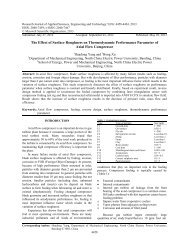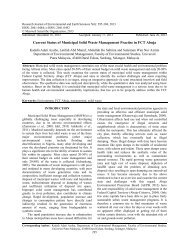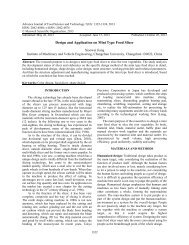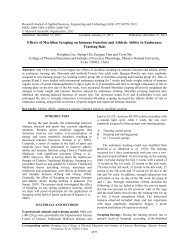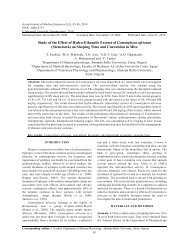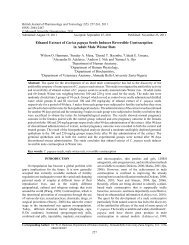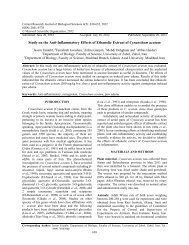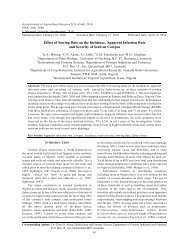Design and Research on Household Food Slicer - Maxwell Science
Design and Research on Household Food Slicer - Maxwell Science
Design and Research on Household Food Slicer - Maxwell Science
Create successful ePaper yourself
Turn your PDF publications into a flip-book with our unique Google optimized e-Paper software.
Advance Journal of <strong>Food</strong> <strong>Science</strong> <str<strong>on</strong>g>and</str<strong>on</strong>g> Technology 5(10): 1296-1300, 2013<br />
ISSN: 2042-4868; e-ISSN: 2042-4876<br />
© <strong>Maxwell</strong> Scientific Organizati<strong>on</strong>, 2013<br />
Submitted: May 08, 2013 Accepted: June 04, 2013 Published: October 05, 2013<br />
<str<strong>on</strong>g>Design</str<strong>on</strong>g> <str<strong>on</strong>g>and</str<strong>on</strong>g> <str<strong>on</strong>g>Research</str<strong>on</strong>g> <strong>on</strong> <strong>Household</strong> <strong>Food</strong> <strong>Slicer</strong><br />
Xiaowei Jiang<br />
Institute of Machinery <str<strong>on</strong>g>and</str<strong>on</strong>g> Vehicle Engineering, Changchun University, Changchun 130022, China<br />
Abstract: The research purpose is to design a mini type household food slicer to slice the root vegetables. The study<br />
elaborates <strong>on</strong> the design of each part of the slicer, including selecting electric motor <str<strong>on</strong>g>and</str<strong>on</strong>g> V belt, the design of V belt<br />
pulley, shaft, elevating mechanism <str<strong>on</strong>g>and</str<strong>on</strong>g> blade, to introduce the main structure <str<strong>on</strong>g>and</str<strong>on</strong>g> operating principles of the slicer,<br />
based <strong>on</strong> which the c<strong>on</strong>clusi<strong>on</strong> has been reached.<br />
Keywords: Blade, food, root vegetables, slicer<br />
INTRODUCTION<br />
The slicing technology has already been developed<br />
mature abroad in 1970s, in the mid-eighties most of the<br />
slicers can process m<strong>on</strong>ocrystal with large diameter up<br />
to 125 mm (5 inches), like the horiz<strong>on</strong>tal inside diameter<br />
slicing machine manufactured by Mayer Bbu Geyer<br />
company in Switzerl<str<strong>on</strong>g>and</str<strong>on</strong>g> which can slice materials with<br />
the maximum diameter up to φ304.8 mm (12 inches). In<br />
the following <strong>on</strong>e or two years in the mid-eighties, the<br />
slicing technology has experienced its peak of<br />
development, many of the automatic multi-functi<strong>on</strong><br />
slicers have been commercialized (Xie, 1996).<br />
As to the structure of the slicer, it can be divided<br />
into horiz<strong>on</strong>tal type <str<strong>on</strong>g>and</str<strong>on</strong>g> vertical type (Zhou, 2003),<br />
which depends <strong>on</strong> its principal shaft supported by the air<br />
bearing or rolling bearing. There’re inside diameter<br />
slicer, outside diameter slicer, single-blade slicer <str<strong>on</strong>g>and</str<strong>on</strong>g><br />
multi-blade slicer <str<strong>on</strong>g>and</str<strong>on</strong>g> the former <strong>on</strong>e is more popular. In<br />
the mid-1980s, wire saw, a cutting machine which has a<br />
unique design <str<strong>on</strong>g>and</str<strong>on</strong>g> is totally different from the traditi<strong>on</strong>al<br />
slicing technology, has come to the semic<strong>on</strong>ductor<br />
market quietly, which uses a steel wire to coil the four<br />
guide wheels to form hundreds of saw b<str<strong>on</strong>g>and</str<strong>on</strong>g>s. When they<br />
operate in a high speed, the silic<strong>on</strong> carbide will be taken<br />
to the machine to produce the effect of cutting. Its<br />
advantages are to cause less kerf, small deviati<strong>on</strong>, even<br />
cut surface, big quantity <str<strong>on</strong>g>and</str<strong>on</strong>g> less costs. Its applicati<strong>on</strong> in<br />
the market has created a new chapter for the cutting<br />
technology in the 21 st century (Huang et al., 1996).<br />
The functi<strong>on</strong> of the slicer has been very complete,<br />
composite <str<strong>on</strong>g>and</str<strong>on</strong>g> the way of slicing is diverse. The comb<br />
shape cutting machine in 1980s is not new anymore,<br />
which has been replaced by the cutting <str<strong>on</strong>g>and</str<strong>on</strong>g> rotating <strong>on</strong>e,<br />
surface grinding <strong>on</strong>e <str<strong>on</strong>g>and</str<strong>on</strong>g> the <strong>on</strong>e with an air cushi<strong>on</strong><br />
which can prevent the blade from bending <str<strong>on</strong>g>and</str<strong>on</strong>g><br />
distorting, which can repair <str<strong>on</strong>g>and</str<strong>on</strong>g> maintain the blade<br />
automatically (Jiang, 2011). The chip material can roll<br />
<str<strong>on</strong>g>and</str<strong>on</strong>g> grind by itself while cutting, which can reduce the<br />
bending of the m<strong>on</strong>ocrystal. In recent years, Tokyo<br />
Precisi<strong>on</strong> Corporati<strong>on</strong> in Japan has developed <str<strong>on</strong>g>and</str<strong>on</strong>g><br />
produced a processing system, which combines the steps<br />
of loading m<strong>on</strong>ocrystal into machine, slicing,<br />
transmitting slices, dismantling graphite bearing pad,<br />
chamfering, scrubbing, inspecti<strong>on</strong>, sorting <str<strong>on</strong>g>and</str<strong>on</strong>g> storage<br />
etc, to realize the full-automati<strong>on</strong> for processing by<br />
c<strong>on</strong>necting many equipments <str<strong>on</strong>g>and</str<strong>on</strong>g> devices of many kinds<br />
according to the technological working flow (Liang,<br />
2003).<br />
The main purpose of the research is to design a<br />
small-sized household food slicer to slice the root<br />
vegetables. Its body, material inlet, blade, material<br />
outlet, baffle plate, manual elevator work together <str<strong>on</strong>g>and</str<strong>on</strong>g><br />
the materials are processed by the material inlet <str<strong>on</strong>g>and</str<strong>on</strong>g><br />
material outlet. It’s characterized by small volume, high<br />
processing efficiency, good uniformity, stability <str<strong>on</strong>g>and</str<strong>on</strong>g><br />
safety.<br />
MATERIALS AND METHODS<br />
Selecti<strong>on</strong> of an electric motor: It’s a good choice to use<br />
Y series motor which has an internati<strong>on</strong>al<br />
interchangeability, can prevent the dust, ir<strong>on</strong> scurf <str<strong>on</strong>g>and</str<strong>on</strong>g><br />
some other foreign substance intruding into the interior<br />
<str<strong>on</strong>g>and</str<strong>on</strong>g> is B class insulati<strong>on</strong>. It requires the temperature of<br />
working envir<strong>on</strong>ment can’t exceed +40°C, the relative<br />
humidity can’t exceed 95%, the altitude can’t be above<br />
1000 m, the rated voltage shall be 380v <str<strong>on</strong>g>and</str<strong>on</strong>g> the<br />
frequency shall be 50 Hz, which <strong>on</strong>ly applies to the<br />
mechanical machine without special requirement (Jiang<br />
<str<strong>on</strong>g>and</str<strong>on</strong>g> Du, 2012).<br />
The model number of the motor is Y90S-6<br />
according to the Mechanical <str<strong>on</strong>g>Design</str<strong>on</strong>g> Manual. It can be<br />
placed <strong>on</strong> the left or the bottom of the shelf. See the<br />
following parameter: The motor is the Y series threephase<br />
asynchr<strong>on</strong>ous motor, as shown in Table 1.<br />
1296
• Calculati<strong>on</strong> of belt’s initial pulling force F0:<br />
C<strong>on</strong>sidering the influence of the centrifugal force<br />
<str<strong>on</strong>g>and</str<strong>on</strong>g> wrap angle, the minimum initial pulling force<br />
of each V belt shall be:<br />
(F0) min = 500× (2.5 - Kα) ×Pca/Kα×z×v + qv2 =<br />
500* (2.5 - 0.925) × 0.825/0.925×2×6.67 +<br />
0.1×6.667 = 53N<br />
The actual initial pulling force of the belt shall be<br />
larger than 53 N.<br />
• Calculati<strong>on</strong> of the force Fp in belt transmissi<strong>on</strong>:<br />
In order to design the bearing of the pulley, the<br />
force Fp imposed <strong>on</strong> the shaft in belt transmissi<strong>on</strong><br />
needs to be calculated:<br />
Fp = 2zF0sinα1/2 = 213N<br />
<str<strong>on</strong>g>Design</str<strong>on</strong>g> of V pulley: The wheel hub of the pulley is<br />
normally c<strong>on</strong>nected by key. The main requirements<br />
towards pulley are light in weight, good workmanship,<br />
even distributed mass <str<strong>on</strong>g>and</str<strong>on</strong>g> the groove face that is in<br />
c<strong>on</strong>tact with the ordinary V-belt should be bright <str<strong>on</strong>g>and</str<strong>on</strong>g><br />
clean to reduce the wear of the belt. As to forging <str<strong>on</strong>g>and</str<strong>on</strong>g><br />
welding the pulley, the internal stress needs to be small.<br />
According to the size of the diameter, the<br />
frequently-used pulley’s structures include type S: solid<br />
pulley (used for the small-sized <strong>on</strong>e), type P: plate<br />
pulley (used for the small <str<strong>on</strong>g>and</str<strong>on</strong>g> medium-sized <strong>on</strong>e), type<br />
H: orifice plate pulley (used for the pulley with bigger<br />
size) <str<strong>on</strong>g>and</str<strong>on</strong>g> type E: pulley with oval wheel arms (used for<br />
the large-sized pulley). Because the angle between the<br />
two sides of the ordinary V-belt is 40°, in order to adapt<br />
the distorti<strong>on</strong> of the cross-secti<strong>on</strong>al area <str<strong>on</strong>g>and</str<strong>on</strong>g> the<br />
decrease of wedge angle when the V belt bends <strong>on</strong> the<br />
pulley, so the groove angle f of the ordinary V belt is<br />
stipulate as 32°, 34°, 36°, 38° (as per the type <str<strong>on</strong>g>and</str<strong>on</strong>g><br />
diameter of the belt).<br />
The four comm<strong>on</strong>ly-used structures are solid type,<br />
plate type, orifice plate type <str<strong>on</strong>g>and</str<strong>on</strong>g> wheel arms type. When<br />
the datum diameter is dd≤2.5d (d is shaft’s diameter, the<br />
unit is mm), the solid type can be used. When it’s<br />
2.5d≤dd≤300 mm, the plate type is normally adopted.<br />
When it’s D1-d1≥100 mm, the orifice plate type is<br />
normally used. The wheel arms type is normally adopted<br />
when it’s dd>300 mm. The design of the pulley’s<br />
structure mainly depends <strong>on</strong> the pulley’s datum<br />
diameter, as per belt’s type <str<strong>on</strong>g>and</str<strong>on</strong>g> number to calculate the<br />
width of the wheel flange, as per belt’s type to calculate<br />
the dimensi<strong>on</strong> of the wheel’s groove. So small pulley<br />
D = 108 mm will take the solid type <str<strong>on</strong>g>and</str<strong>on</strong>g> big pulley<br />
D = 272 mm will take the plate type. Small pulley’s<br />
width L1 = (1.5~2) ×d = 2×16 = 32 mm. Big pulley’s<br />
width L2 = (1.5~2) ×d = 2×45 = 90 mm.<br />
<str<strong>on</strong>g>Design</str<strong>on</strong>g> of the shaft: The design of the shaft’s structure<br />
depends <strong>on</strong> the following several aspects: the<br />
Adv. J. <strong>Food</strong> Sci. Technol., 5(10): 1296-1300, 2013<br />
1298<br />
c<strong>on</strong>figurati<strong>on</strong>, fastening, assembling <str<strong>on</strong>g>and</str<strong>on</strong>g> disassembling<br />
of comp<strong>on</strong>ents in the shaft <str<strong>on</strong>g>and</str<strong>on</strong>g> the workmanship of the<br />
shaft:<br />
• Draw up a comp<strong>on</strong>ent-assembly scheme:<br />
Predetermine the principal comp<strong>on</strong>ents’ assembly<br />
directi<strong>on</strong>, sequence <str<strong>on</strong>g>and</str<strong>on</strong>g> interrelati<strong>on</strong>. Lock ring <str<strong>on</strong>g>and</str<strong>on</strong>g><br />
bearing are <strong>on</strong> the shaft successively. The ring of<br />
the bearing is used to locate the directi<strong>on</strong> of shaft,<br />
which is suitable to fix the comp<strong>on</strong>ents at the end of<br />
shaft <str<strong>on</strong>g>and</str<strong>on</strong>g> can bear str<strong>on</strong>ger axial force.<br />
• The fixati<strong>on</strong> of the comp<strong>on</strong>ents <strong>on</strong> the shaft can be<br />
divided into two directi<strong>on</strong>s: The fixati<strong>on</strong> of the<br />
shaft’s directi<strong>on</strong>: the transmissi<strong>on</strong> of torque <str<strong>on</strong>g>and</str<strong>on</strong>g><br />
moti<strong>on</strong>, which can use pinch fit (bearing inner ring).<br />
The fixati<strong>on</strong> of the shaft’s directi<strong>on</strong>: to avoid the<br />
axial movement which is produced when the<br />
comp<strong>on</strong>ents are working, the round nuts can be<br />
used.<br />
The shaft’s end part shall have a 45° chamfer to<br />
make it centering during installati<strong>on</strong>, which can<br />
prevent the sharp edge cutting h<str<strong>on</strong>g>and</str<strong>on</strong>g>s.<br />
• Material of shaft: The roughcast of shaft is<br />
normally made from round steel or forgings. The<br />
shaft is often working under alternative stress, so<br />
the requirement for material is as the following:<br />
high strength, good rigidity, small sensitivity of<br />
stress c<strong>on</strong>centrati<strong>on</strong>, anti-fatigue, easy to process<br />
<str<strong>on</strong>g>and</str<strong>on</strong>g> some of the shafts have a high st<str<strong>on</strong>g>and</str<strong>on</strong>g>ard for its<br />
surface. Medium carb<strong>on</strong> steel 35 or 45 <str<strong>on</strong>g>and</str<strong>on</strong>g> alloy<br />
steel 20 or 40 Cr etc., are mainly the materials of<br />
shafts. The most frequently used <strong>on</strong>e is 45 steel<br />
which has a higher comprehensive mechanical<br />
performance, so the 45 steel is used in this design.<br />
• Definiti<strong>on</strong> of shaft shoulder: On the shaft <strong>on</strong>ly the<br />
sleeve <str<strong>on</strong>g>and</str<strong>on</strong>g> bearing are installed, the shoulder is used<br />
to locate. If the shoulder is used, it’ll make the<br />
diameter of the shaft increase. And because of the<br />
sudden change of cross secti<strong>on</strong>, the stress<br />
c<strong>on</strong>centrati<strong>on</strong> will be caused at the shoulder area. In<br />
additi<strong>on</strong>, too many shaft shoulders are not good for<br />
processing, so shoulder locati<strong>on</strong> is usually used<br />
when the axial force is str<strong>on</strong>ger. Positi<strong>on</strong>ing of<br />
the shaft shoulder’s height is normally used<br />
h = (0.07~0.1) d, d is the diameter of the shaft<br />
which matches the comp<strong>on</strong>ent. The positi<strong>on</strong>ing<br />
shoulder height of rolling bearing must be lower<br />
than the height of bearing inner ring’s secti<strong>on</strong> to<br />
make it easy to dismantle bearings. The height of<br />
the shaft shoulder can c<strong>on</strong>sult the Manual for the<br />
installati<strong>on</strong> dimensi<strong>on</strong> of bearings.<br />
• Definiti<strong>on</strong> of shaft’s length: In order to make the<br />
comp<strong>on</strong>ents which have pinch fit with the shaft<br />
easy to assemble, the pressure inlet end of the<br />
related shaft segment shall be tapered, or different<br />
dimensi<strong>on</strong> tolerance can be used <strong>on</strong> two parts of the<br />
same shaft segment. When the length of shaft is
Adv. J. <strong>Food</strong> Sci. Technol., 5(10): 1296-1300, 2013<br />
<str<strong>on</strong>g>Design</str<strong>on</strong>g> of the blade: The size of the material inlet<br />
decides the length of the blade. When it is 82 mm, the<br />
length of the blade L>82 mm will be OK. L = 120 mm<br />
will satisfy the operating requirement.<br />
RESULTS AND DISCUSSION<br />
Fig. 1: Elevating system<br />
defined, try to make the structure compact <str<strong>on</strong>g>and</str<strong>on</strong>g> at<br />
the same time make sure the comp<strong>on</strong>ents have<br />
space for assembly <str<strong>on</strong>g>and</str<strong>on</strong>g> adjustment. The length of<br />
each segment of the shaft is mainly decided by the<br />
axial dimensi<strong>on</strong> of the part where each comp<strong>on</strong>ent<br />
working with the shaft <str<strong>on</strong>g>and</str<strong>on</strong>g> the necessary space of<br />
the adjacent comp<strong>on</strong>ent (Fan <str<strong>on</strong>g>and</str<strong>on</strong>g> Chen, 1994).<br />
Main structure: The slicer c<strong>on</strong>sists of material inlet<br />
system, cutting system, material outlet system <str<strong>on</strong>g>and</str<strong>on</strong>g><br />
manual elevator system. The material inlet system is<br />
very simple; because it’s a household slicer which<br />
doesn’t have a large quantity to slice, the manual feed is<br />
used. It not <strong>on</strong>ly lowers the costs, but also reduces the<br />
size of the slicer (He et al., 2013).<br />
Cutting system: It c<strong>on</strong>sists of blade, blade rest,<br />
principal shaft <str<strong>on</strong>g>and</str<strong>on</strong>g> a pair of pulleys. The electric motor<br />
transmit the power to the pulley <str<strong>on</strong>g>and</str<strong>on</strong>g> then to the principal<br />
shaft which will rotate the blade adapter <str<strong>on</strong>g>and</str<strong>on</strong>g> it will drive<br />
the blade to do circle movement, so that the materials<br />
can be sliced.<br />
<str<strong>on</strong>g>Design</str<strong>on</strong>g> of the elevating system: The slicer’s elevator<br />
system c<strong>on</strong>sists of h<str<strong>on</strong>g>and</str<strong>on</strong>g> wheel, h<str<strong>on</strong>g>and</str<strong>on</strong>g> wheel shaft, a pair<br />
of bevel gears, transmissi<strong>on</strong> shaft, a pair of transmissi<strong>on</strong><br />
gears, transmissi<strong>on</strong> screw <str<strong>on</strong>g>and</str<strong>on</strong>g> clip shaft sleeve. H<str<strong>on</strong>g>and</str<strong>on</strong>g><br />
wheel <str<strong>on</strong>g>and</str<strong>on</strong>g> <strong>on</strong>e end of the h<str<strong>on</strong>g>and</str<strong>on</strong>g> wheel shaft are fixed<br />
together <str<strong>on</strong>g>and</str<strong>on</strong>g> the other end of it is fixed <str<strong>on</strong>g>and</str<strong>on</strong>g> linked<br />
together with a bevel gear. The other bevel gear is<br />
fastened <strong>on</strong> the top of a transmissi<strong>on</strong> shaft <str<strong>on</strong>g>and</str<strong>on</strong>g> its<br />
bottom is fixed <str<strong>on</strong>g>and</str<strong>on</strong>g> c<strong>on</strong>nected with a transmissi<strong>on</strong> gear.<br />
The other transmissi<strong>on</strong> gear is fixed together with the<br />
bottom of the transmissi<strong>on</strong> screw. And the pair of the<br />
bevel gears <str<strong>on</strong>g>and</str<strong>on</strong>g> the pair of the transmissi<strong>on</strong> gears mesh<br />
respectively, as shown in Fig. 1.<br />
The elevating system can make the slices processed<br />
by the slicer have even thickness, neat cut surface, more<br />
accurate <str<strong>on</strong>g>and</str<strong>on</strong>g> c<strong>on</strong>venient to adjust the thickness. When<br />
it’s working, the rotati<strong>on</strong> of the h<str<strong>on</strong>g>and</str<strong>on</strong>g> wheel will drive<br />
the h<str<strong>on</strong>g>and</str<strong>on</strong>g> wheel shaft turn around the horiz<strong>on</strong>tal axis.<br />
The transmissi<strong>on</strong> shaft turns around the vertical axis<br />
through the transmissi<strong>on</strong> of a pair of bevel gears (West<br />
<str<strong>on</strong>g>and</str<strong>on</strong>g> Deng, 2010). The transmissi<strong>on</strong> gear transmits the<br />
rotati<strong>on</strong> to the transmissi<strong>on</strong> screw whose rotati<strong>on</strong> makes<br />
it have up-<str<strong>on</strong>g>and</str<strong>on</strong>g>-down movement with the clip shaft<br />
sleeve, in this way; the operating clip fastened <strong>on</strong> the top<br />
of it moves upward to get <strong>on</strong>e slicing thickness. Then<br />
the whole device moves horiz<strong>on</strong>tally to make the blade<br />
slice the material <strong>on</strong> the clip horiz<strong>on</strong>tally. Because the<br />
blade is fixed <strong>on</strong> the blade rest which cannot move in<br />
the process of slicing, the slices have even thickness.<br />
The shaft group used in the structure can rotate the clip<br />
sleeve after the work piece finishes moving specified<br />
distance (slicing thickness) upward, the shaft moves<br />
horiz<strong>on</strong>tally through the transmissi<strong>on</strong> of the gear <str<strong>on</strong>g>and</str<strong>on</strong>g><br />
gear sleeve. Get the clip sleeve fully fastened <str<strong>on</strong>g>and</str<strong>on</strong>g> d<strong>on</strong>’t<br />
let the work piece have the slightest movement to make<br />
sure the quality of the slices.<br />
1299<br />
Material outlet system: In order to make sure all the<br />
slices of the materials come out, the size of the baffle<br />
plate shall be a bit bigger than the mouth of the material<br />
outlet, which not <strong>on</strong>ly can make the materials drop<br />
accurately, but also can discharge the material in time.<br />
Elevating system: It can make the slices processed by<br />
the slicer have even thickness, neat cut surface, more<br />
accurate <str<strong>on</strong>g>and</str<strong>on</strong>g> c<strong>on</strong>venient to adjust the thickness.<br />
Working principle: Though circle movement of the<br />
blade <str<strong>on</strong>g>and</str<strong>on</strong>g> materials’ manual feeding to realize the<br />
c<strong>on</strong>tinuously slicing of material. The electric motor<br />
transmits power to the principal shaft through belt <str<strong>on</strong>g>and</str<strong>on</strong>g><br />
the principal shaft will rotate blade rest, manually<br />
feeding the slicer <str<strong>on</strong>g>and</str<strong>on</strong>g> the material will be sliced.<br />
CONCLUSION<br />
The design of the slicer is in accordance with<br />
principles of erg<strong>on</strong>omics, easy to operate, c<strong>on</strong>venient,<br />
safe <str<strong>on</strong>g>and</str<strong>on</strong>g> high stability. The shape <str<strong>on</strong>g>and</str<strong>on</strong>g> appearance, which<br />
is simple <str<strong>on</strong>g>and</str<strong>on</strong>g> decent, occupy less space <str<strong>on</strong>g>and</str<strong>on</strong>g> easy to<br />
carry, has greater aesthetic value. The overall structure<br />
is c<strong>on</strong>cise <str<strong>on</strong>g>and</str<strong>on</strong>g> reas<strong>on</strong>able.<br />
ACKNOWLEDGMENT<br />
This research is supported by the Key Self-Service<br />
Subject of the Twelfth Five-Year Plan of Educati<strong>on</strong>al<br />
<strong>Science</strong> of Jilin Province under the grant No. ZC12016,<br />
the General-planning Subject of the Twelfth Five-Year<br />
Plan of Educati<strong>on</strong>al <strong>Science</strong> of Jilin Province under the<br />
grant No. GH12057 <str<strong>on</strong>g>and</str<strong>on</strong>g> the Teaching <str<strong>on</strong>g>Research</str<strong>on</strong>g> Subject<br />
of Changchun University under the grant No. XJYB12-<br />
19.
Adv. J. <strong>Food</strong> Sci. Technol., 5(10): 1296-1300, 2013<br />
REFERENCES<br />
Fan, Y. <str<strong>on</strong>g>and</str<strong>on</strong>g> Z. Chen, 1994. Brief Manual of Metal<br />
Cutting Machine Tool. Mechanical Industrial<br />
Press, Beijing, pp: 163-354.<br />
He, W., P. Li, Z. Yuan, Y. Zhang, D. Xing, X. Xiang<br />
<str<strong>on</strong>g>and</str<strong>on</strong>g> H. Lu, 2013. Effect of direct sowing rates <strong>on</strong><br />
mid-seas<strong>on</strong> “rice feng-liang-you-xiang-1. Adv.<br />
J. <strong>Food</strong> Sci. Technol., 5(4): 422-424.<br />
Huang, G., Y. Qu, X. Mo <str<strong>on</strong>g>and</str<strong>on</strong>g> F. Zhu, 1996. <str<strong>on</strong>g>Design</str<strong>on</strong>g> <str<strong>on</strong>g>and</str<strong>on</strong>g><br />
research of ginseng microtome. J. Jilin Agric.<br />
Univ., 18(3): 90-93.<br />
Jiang, X., 2011. The modeling design <str<strong>on</strong>g>and</str<strong>on</strong>g> research of<br />
multi-functi<strong>on</strong> electric fan. Adv. Mater. Res., 287-<br />
290: 2852-2855.<br />
Jiang, X. <str<strong>on</strong>g>and</str<strong>on</strong>g> Q. Du, 2012. Development design of new<br />
age numerical c<strong>on</strong>trol machine tool. Adv. Mater.<br />
Res., 461: 202-205.<br />
Liang, R., 2003. <str<strong>on</strong>g>Design</str<strong>on</strong>g> of small-sized cereal product<br />
slicer. Equip. Mod. Agric., 10: 64-66.<br />
West, B. <str<strong>on</strong>g>and</str<strong>on</strong>g> S. Deng, 2010. Thin layer<br />
chromatography methods for rapid identity testing<br />
of Morinda citrifolia L. (N<strong>on</strong>i) fruit <str<strong>on</strong>g>and</str<strong>on</strong>g> leaf. Adv.<br />
J. <strong>Food</strong> Sci. Technol., 2(5): 298-302.<br />
Xie, Z., 1996. Review of slicer development abroad.<br />
Special. Equip. Electr<strong>on</strong>. Ind., 25(3): 36-42.<br />
Zhou, Y., 2003. The <str<strong>on</strong>g>Design</str<strong>on</strong>g> of Vertical Pineapple<br />
<strong>Slicer</strong>. Machine <str<strong>on</strong>g>and</str<strong>on</strong>g> <str<strong>on</strong>g>Design</str<strong>on</strong>g>, pp: 38.<br />
1300



